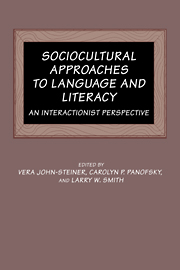Book contents
- Frontmatter
- Contents
- List of contributors
- 1 Introduction
- Part 1 Context
- Part II Mediational processes
- Part III Functional systems
- 11 Adults learning literacy: The role of private speech in reading comprehension
- 12 From “Paj Ntaub” to paragraphs: Perspectives on Hmong processes of composing
- 13 Toward a definition of law school readiness
- Author index
- Subject index
12 - From “Paj Ntaub” to paragraphs: Perspectives on Hmong processes of composing
Published online by Cambridge University Press: 05 November 2011
- Frontmatter
- Contents
- List of contributors
- 1 Introduction
- Part 1 Context
- Part II Mediational processes
- Part III Functional systems
- 11 Adults learning literacy: The role of private speech in reading comprehension
- 12 From “Paj Ntaub” to paragraphs: Perspectives on Hmong processes of composing
- 13 Toward a definition of law school readiness
- Author index
- Subject index
Summary
INTRODUCTION
“Women learn like animals. Men study in their heads.” Dia Xiong Vang, a Hmong refugee from Laos, protested her placement in a class of men and women studying English language and literacy in 1979. The recently resettled men and women from southeast Asia had been assigned to the same class in a community-based program in Providence, Rhode Island. In explaining this distinction between men and women, Dia confided to me, her teacher, that studying alongside men terrified her. Her perception of men's superior intelligence eroded the little selfconfidence she had. Variations of her fear and argument recur often in my conversations with Hmong women concerning their apprehensions about studying literacy.
These remarks about learning and gender differences provoked my curiosity and added a new dimension to my inquiry into Hmong culture. The need to address the issue of a culturally appropriate pedagogy engaged me in an ongoing pursuit, supported by my belief that educators need to examine the historical and social sources of learners' attitudes toward reading, writing, and thinking processes.
This ongoing study is a collaborative effort with participants as informants rather than as subjects (Heath, 1983; McNiff, 1988). It originates in the field, in homes and in classrooms where adults learn rather than in more traditional academic settings. The approach is strengthened by “creative dialogue between members of a community which includes teachers, academics, parents, students, etc.” (Whitehead, 1988, p. x).
- Type
- Chapter
- Information
- Sociocultural Approaches to Language and LiteracyAn Interactionist Perspective, pp. 331 - 346Publisher: Cambridge University PressPrint publication year: 1994
- 11
- Cited by



